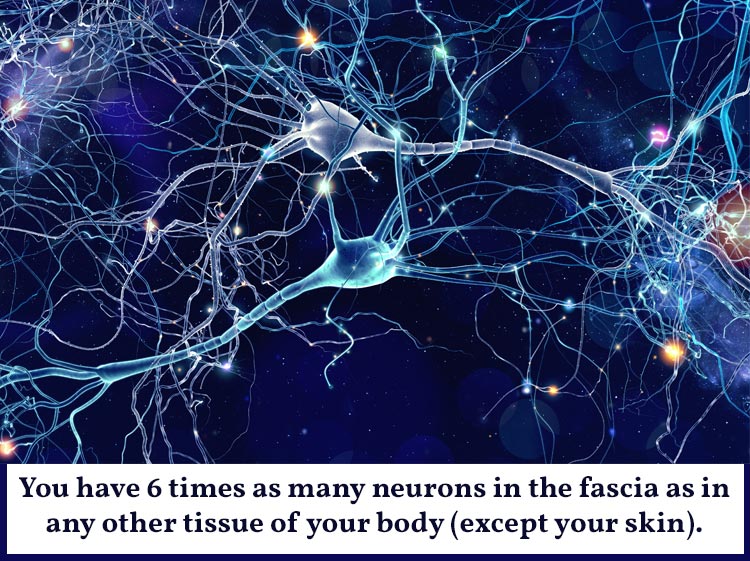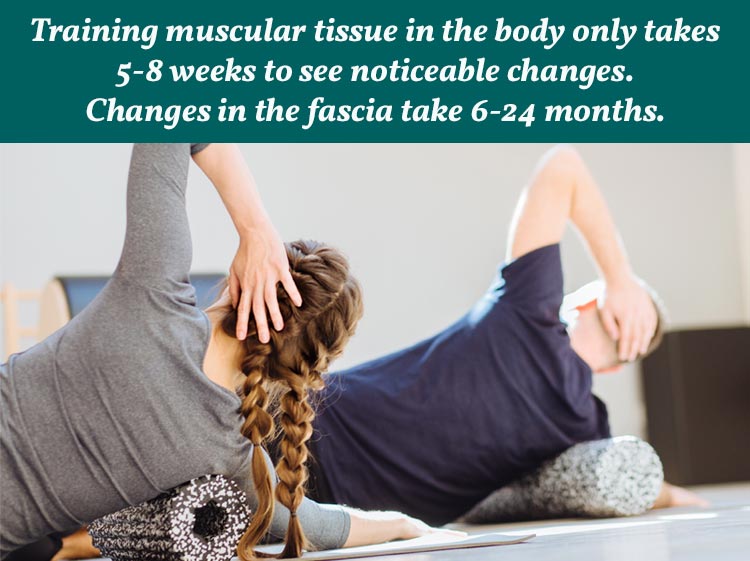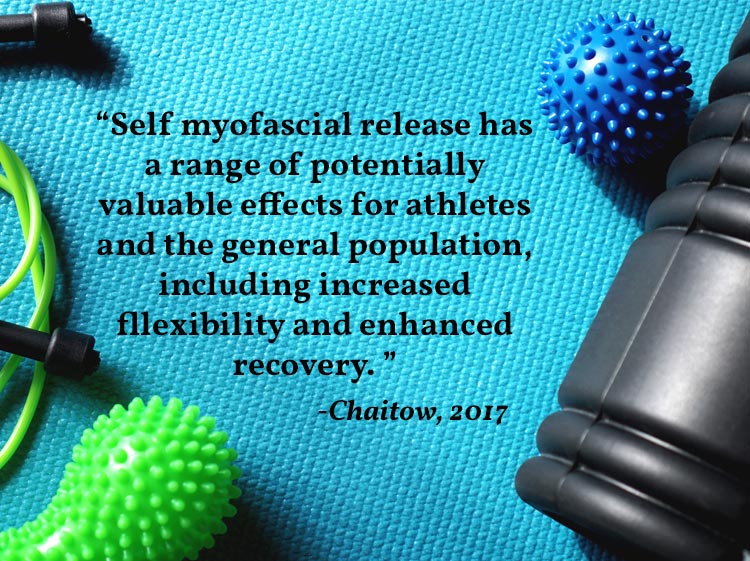 As a yoga professional, you’re constantly looking for more ways to understand–and serve–the needs of your clients. When you have knowledge about the body, you can discern imbalances in your students with clarity. You can modify postures to keep them safe. And, you can confidently create private lesson plans that will reduce their pain, increase their vitality, and allow students to reach their goals. The fun facts about fascia in this post will help you do all of this–and more!
As a yoga professional, you’re constantly looking for more ways to understand–and serve–the needs of your clients. When you have knowledge about the body, you can discern imbalances in your students with clarity. You can modify postures to keep them safe. And, you can confidently create private lesson plans that will reduce their pain, increase their vitality, and allow students to reach their goals. The fun facts about fascia in this post will help you do all of this–and more!
I recently attended a weeklong retreat with Tiffany Cruikshank–founder of Yoga Medicine–on the topic of Myofascial Release. It was an intensive dive into the anatomy of the fascia, and how we can use yoga to improve the health of this tissue in the body.
What I found most exciting is how far the scientific community has come on this topic. When I received my master’s degree in sports kinesiology over 10 years ago, fascia was a minimal part of the conversation. In fact, fascia was thrown away when dissecting a cadaver because it was thought of as unimportant and unuseful.
But, oh how the tides have turned. The fascia is a healing pathway that is in constant communication with the entire body. The tissue in this network is resilient, and it allows you to find balance in spite of the ongoing demands in your life. My goal in this post is to share exciting insights about fascia so you can better understand–and address–the needs of your own body (and that of your yoga community as well).
Photo Credit: Ember and Earth Photography
TEST YOUR FASCIA IQ
I think one of the best ways to learn new information is through a fun, interactive activity. It’s also one of the quickest means to recall the knowledge that’s tucked away in the back of your mind as well. That’s why I created this Fascia Quiz below.
Instructions:
Reach each statement below. Then decide if the statements are true or false. Once you’ve completed all 10 questions, check your results with our answer key below.
- Fascia is the connective tissue of the body.
- Fascia is the largest sensory organ in the body.
- The purpose of your fascia is to give the body structure, support your organs, and help the body adapt to changing demands in life.
- Fascial tissue changes quickly.
- Your hydration levels affect the health of your fascia.
- Fascia helps regulate immune function in your body.
- Crosslinks in the fascia are where adjacent tissues become stuck to one another.
- The goal of myofascial release is to remove obstacles in the fascia, increase the flow of nerve signals in the tissue, and restore its overall integrity.
- Aggressive, persistent myofascial release can benefit the fascia.
- Repetitive movements in yoga can increase fascia health.

Photo Credit: Whitehoun
FASCIA ANSWER KEY
Here are the answers to the questions posed above, along with some additional facts about fascia.
1. TRUE
Fascia is the connective tissue of the body. There is a superficial layer that runs from head to toe, just under the skin, which protects the body and provides a sense of support. Then, there is a deeper layer that surrounds–and weaves through–all of the muscles of the body.
2. TRUE
The body’s fascia houses sensory nerves that constantly absorb information from your environment via your senses. In fact, it takes in more data than your brain about the conditions inside of your body AND outside of it! The fascia picks up each small change in your weight, body position, and various movements. And it stores this information to help you sustain homeostasis.
3. TRUE
Your fascia works wonders to keep you alive and well each day. First, it provides a sense of support for the structure of your body. Fascia essentially provides the framework in which your bones, muscles, nerves, and organs connect. Second, it’s a layer that surrounds and protects your vital internal organs. And, it’s this entire network of support that allows your body to absorb physical stress without distorting your shape.
4. FALSE
Your fascia is constantly–but slowly–responding to the demands placed on your body. In fact, the collagen networks of the fascia rearrange over time to help you move in ways your lifestyle requires. If you’re a new mom carrying a baby around for months on end, your fascia will adjust to help your body sustain that load. Or, if you play a specific sport–such as volleyball or baseball or golf–you must build strength and coordination to perform at high levels. Your fascia will adjust to help you do this.

Photo Credit: Iryna
5. TRUE
60% of the adult human body is comprised of water, and staying hydrated can increase your overall health. This is also true for your connective tissue. One component of fascia is collagen fibers, which resist the deformation of the tissue and help your body heal. For collagen to remain healthy, though, you must be hydrated.
Water also comprises a majority of the ground substance found in the fascia. This thick, gel-like fluid fills the space between fibers and cells in this connective tissue and helps the muscles of your body glide past one another smoothly. If you’re dehydrated, your muscles will be like sandpaper rubbing against one another (which sounds miserable, right?) Instead, stay hydrated in order to maintain smooth, coordinated, and efficient body movement.
6. TRUE
White blood cells and fibroblasts are the two main types of cells in fascia. Macrophages, or white blood cells, regulate immune function and inflammation in the body. In the deep fascia, there are also myofibroblasts that assist in wound healing. Therefore, healthy fascia can greatly contribute to the immune function of the body. It can allow the body to be more resilient in the face of toxins, stress, and damage to tissue from trauma, injury, or simple wear and tear from everyday life activities.
7. TRUE
If you were to look through a microscope at healthy fascia tissue, you’d see packed collagen fibers that form a wavy pattern. This allows the tissue of the fascia–and the other tissue of the body, such as muscles–to stretch and move without restriction.
Yet, if crosslinks form in the fascia, that healthy movement isn’t possible. Crosslinks are adhesions in the tissue and where fascia gets stuck. They act like velcro in the body and cause tension, pain, and reduced blood flow to the fascial network.
Crosslinks can occur because of physical trauma, emotional stress, aging, or overuse. To prevent this, or heal from injury, you can use myofascial release techniques to repair this tissue.
8. TRUE
Myofascial release (MFR) is any technique you can use to manipulate muscles and fascia. You are probably familiar with some myofascial techniques, like compressing a point on the body with a tennis ball or rolling out a tight muscle with a foam roller.
While there are many ways to use MFR, the main goals are to release adhesions, restore the order of collagen fibers in the tissue, and restore neuromuscular connections. Plus, it’s a great way to restore (and increase) the elastic potential of muscles–with translates to more length, strength, and flexibility.
9. FALSE
As you probably know, more isn’t always better. This is also true when it comes when using myofascial release (MFR) techniques to improve fascial health. Try to vary how you address your connective tissue. Sometimes work on a more superficial level. Other times work more deeply. One day you might build strength; the next, mobility.
And, you most definitely want to avoid an aggressive approach to alter your fascia. It can trigger more inflammation in the body, which results in more internal stress and activates the parasympathetic nervous system. This can delay–or even inhibit–the desired healing effect you’re after.
10. FALSE
Yes, it’s true that yoga is one of the best ways to stretch and compress the tissues of the body–including the fascia. Yoga is also a wonderful way to increase proprioception (balance) and overall body awareness.
Yet, the best way for fascial health and resilience to be attained is through a variety of movements. You want to use slow, mindful movements of your body in new directions to stress different points on the tension system. Thus, repetitive movements in yoga won’t necessarily help improve your fascia.

Photo Credit: Brillianata
HOW THIS RELATES TO YOGA
While it’s great to increase your knowledge about the fascia, it’s more important to know how it relates to your life (especially as a yoga professional). So, here are 3 tips on how you can pass on this knowledge to your students in a meaningful way.
Pass it on.
Share some of these fun facts with your students. Just by reading this information out loud to others can more deeply seat this information in the brain. And, it can help your clients identify how and why yoga is important to their ongoing health.
Add variety to your classes.
Since you now know that repetitive movements in yoga are less beneficial to fascial health, add some variety to your classes. Instead of holding certain postures, like horse stance, add some mindful lateral stretches that move with the breath. Or, try cactus arms with vrksasana legs … or eagle arms with warrior 1 legs.
Reduce the intensity of each stretch.
When you take familiar yoga movements and reduce the degree to which you take them, students can tune into the superficial layer of the fascia. This layer of the tissue connects the entire body–from the bottom of the feet to the crown of the head–just below the surface of the skin. Instead of going for the deepest variation of each posture, which affects the deeper connective tissue as well as the muscular tissue, try backing off. Have your students only go 60-70% of their maximum. Then invite them to notice how this changes their experience in each pose.
Pause between postures.
The number one way to help your fascia is to increase your awareness of it. Thus, the changes you make to the body during a yoga class also shift the fibers of the fascia. When you invite students to pause during class (taking tadasana, child’s pose, or even savasana), you amplify the ability to perceive such changes. It’s also in these moments you encourage students to be curious
SUGGESTED RESOURCES
Do you want to learn more about the fascia and how it collaborates with the body for overall wellbeing? Here are some books we recommend:
 Anatomy Trains, by Thomas Meyers.
Anatomy Trains, by Thomas Meyers.
As a yoga professional, you work with a wide array of clients and an infinitely diverse set of bodies. This book presents a unique understanding of the role of fascia plays in healthy movement. Plus, it examines postural distortion and how to use bring bodies back into balance.
 The Spark in the Machine, by Dr. Daniel Keown.
The Spark in the Machine, by Dr. Daniel Keown.
The human body is incredibly resilient, and fascia is greatly responsible for this adaptive ability due to its amazing ability to communicate and channel energy. In this book, you’ll discover how Qi, or Prana, are understood by both Western and Eastern medicine (and how our understanding of each worldview add to the understanding of how our bodies work!)
 The Complete Guide to Yin Yoga, by Bernie Clark.
The Complete Guide to Yin Yoga, by Bernie Clark.
Yin yoga is one of the best ways to compress and lengthen the fascia. It’s also a fantastic way to rehydrate the tissues of the body, increase strength in these same tissues, and create long-lasting postural change for the better.
PUTTING IT TOGETHER
The fascia in the body is an important player in creating your overall health. When you understand what it is, how it works, and why it’s important, you can pass that important message on to your yoga clients. You can use this knowledge to increase their level of body awareness. And, you have more tools in your arsenal to better serve them and help them reach their goals.
Take Action Now:
- Try any one of our suggested ways to deepen your knowledge about fascia, either by sharing this information with your clients or reading a book on the subject.
- Sample a myofascial release technique, such as in these videos I did a while back to get rid of lower body tension or open the shoulder complex.








Leave A Comment